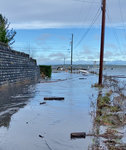

One of the highest tides of 2022 was predicted for just after sunrise Friday, Jan 7. Daylight revealed a tide two feet higher than the prediction. Seawater filled the parking lot of Purdy’s Bridgeway Market. Around the Key Peninsula, bulkheads were submerged, yards flooded and sand spits disappeared.
At the nearest official recording station, in Tacoma, the tide broke the 15-foot mark for the first time in a quarter century of data.
King tides are expected every winter due to the relative positions of the sun and moon, but any given day’s actual tides can vary from the predicted level — usually on the order of inches. The tide Jan. 6 was predicted to be higher than that of Jan. 7. It turned out to be a foot lower than the Friday showstopper.
“What struck me most,” said Rachel Easton of the environmental education nonprofit Harbor WildWatch, “was imagining the volume of rain and snow melt from the entire watershed and how much that fresh water amplified already high tides to create flooding all around the Sound.”
In the 48 hours prior to the high tide, nearly 4 inches of rain fell. At the same time, the New Year’s cold snap ended, thawing snow and ice. Upland flooding was at its highest stage so far this winter.
Other factors contributed, particularly a low-pressure weather system passing directly overhead at the time of the high tide. High atmospheric pressure acts to suppress high tides, while low pressure allows them to rise higher.
At the same time, a southwest wind blew, pushing waves and higher water northeastward, slightly boosting the tide at Purdy and along the eastern shore of Case Inlet.
All of it combined in record-setting fashion to amaze observers around Puget Sound. Citizen scientists helped to document the event by uploading photographs from their homes and local parks to the Department of Natural Resource’s MyCoast portal. Anyone can contribute to the portal’s King Tides project, which creates a map of images of the year’s highest tides.
“King tide events like this give us all a greater appreciation for the power of nature and serve as a preview to how sea level rise from climate change can affect us here on the Key Peninsula,” Easton said. “It’s an excellent reminder to work toward solutions and focus our efforts to become a more resilient community in times of change.”
According to the U.S. National Oceanic and Atmospheric Association, sea level has risen 8 to 9 inches since 1880 and is accelerating. It more than doubled from 0.06 inches per year in most of the twentieth century to 0.14 inches per year between 2006 and 2015. In 2020, global sea level set a record high of 3.6 inches above 1993 levels.
The rate of sea rise is expected to continue to accelerate due to climate chance, though models differ as to how fast.
UNDERWRITTEN BY THE FUND FOR NONPROFIT NEWS (NEWSMATCH) AT THE MIAMI FOUNDATION, THE ANGEL GUILD, ADVERTISERS, DONORS AND PEOPLE WHO SUPPORT INDEPENDENT, NONPROFIT LOCAL NEWS